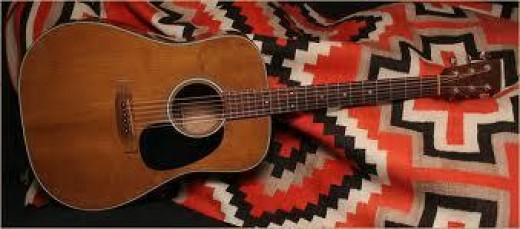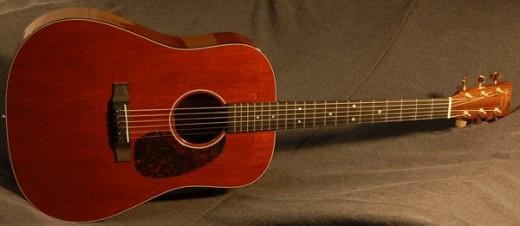A Martin D-19

I've Only Ever Seen One D-19
I've only ever seen one Martin D-19 in my life, and I didn't even get to pick it any. I didn't get to even touch it. I asked about it, and saw it on a Gaston road pawn shop in Dallas, Texas, sometime in the late 1990's. It's a very rare guitar, the D-19. Traditionally, Martin solid wood dreadnoughts or smaller or differing sized instruments start with the number 18, which means the guitar is a mahogany body instrument with a solid spruce top. Following 18 series guitars one then jumps to 28, 35, 41, 42, and then ends at 45 series; but that is only traditionally, and Martin has added new series of guitars along the way, discontinued them, and since added 15 and 16 series guitars, and hopefully those will be here to stay.
Yes, thank you, I know about the 17 series, I own one. I also know about the 21 series, but I've never seen one of those. I have seen just the one Martin D-19, and boy do I ever wish I'd bought that guitar! When we look at the D-19, it is important to realize what we are seeing is something unlike other Martin flat tops, as what our eyes see is something very similar to instruments like the Martin D-17, or the D-15, but this is not due to the tonewood used for the top, it is due to the stain finish.
The Martin D-17 - Very Similar in Appearance, But A Very Different Guitar

C.F. Martin & Company introduced the Dreadnought D-19 flat top guitar to the world in the year 1976, and apparently the year was during a time when Americans had some fascination with the color brown. I've read Fender, Gibson, and Guild guitars were all also following the craze, and putting out new guitars with more brown, and less of creamy spruce color on top. I'm thinking the year was good for high quality finish/stain sales too. Martin produced the D-19 all the way through 1989, but in some years there's data to show they only produced in the range of 50 of these instruments in a year's time.
When it all is said and done, the D-19 is really a Martin D-18 with some dark stain on the spruce top with a D-28 style rosette, and some nice white purfling around the back. These instruments can be found online for around $3000 in good shape, or less should they be a bit scuffed, and maybe need some minor but expert repairs done.
While these guitars are very nice looking, and very collectible, Martin guitars from the 1970's have at times been considered inferior instruments to other decades, and especially when compared to a Martin made from the mid-80's to now, or before the 1970's. It is certainly important to know that these Mid-1970's Martin dreadnoughts DO NOT HAVE the forward shifted and scalloped bracing of the newer Martin guitars, or the Martin's from what is often referred to as the "golden era," and so they simply will not have the volume, clarity, and sustain of such instruments.If what someone is after is both a Martin dreadnought and a dark appearance to set themselves off with looks, then the interested party would do much better, in my opinion, buying a D-15M, or a D-17 if they happened to find one, depending on how much they were willing to spend.
It should absolutely be noted and also be rather apparent, these guitars will sound a lot differently. Nothing, in my opinion, sounds quite like a D-18, and the all mahogany D-15M or D-17 wouldn't sound nearly the same, but one may PREFER the all mahogany sound. The D-19, of course, will by and large sound identical to the D-18.
One thing that comes to mind here, and should be thought of for the very serious man or woman interested in such guitars is there's no possible way the dark stain could NOT affect the tonal characteristics of this guitar in some way. Most guitar tone comes from the topwood, or the tonewood used for the soundboard. Staining a soundboard will absolutely affect the sound; but it could be such a small thing the blindfold testing of D-19 to D-18 would conclude for one the differences are essentially not observable. Some folks have better ears than others though, no doubt about it.
Another thing which comes to mind here is that there are lots of us out there who're a bit "handy" at doing things, like to do things ourselves, and often simply can do outstanding work, even if we've never done that kind of work before. The D-19, however, was created by some of the best in the world, and the idea that one might have of refinishing their fine spruce top guitar to make it look like a D-19 is just a really bad idea. I'm not saying it can not be done, I'm saying only a truly and stupendously foolish person would attempt to refinish a fine guitar without having first experimented many times on such a project with much cheaper instruments - but I'm a pretty opinionated person, and that is my opinion. Thanks for reading.
Del McCoury And His Martin D-19



 9:03 PM
9:03 PM
 Wesman Todd Shaw
Wesman Todd Shaw

0 comments:
Post a Comment